Badan is a decorative herbaceous plant, widely used in the landscaping of country sites, flower and cottage territories. It looks good when landing mono groups, single plants near the artificial reservoirs, or in the company of other plants as part of the Alpine slides. From the leaves of the plant prepare delicious and healthy tea. Rhizomes are used to prepare healing bras and ointments. The second name of the flower - Bergia, in honor of the German nerd Bergen.
Content |
Badan: Description
Badan is a perennial evergreen plant. Refers to the SaxiFragaceae family. In the northern regions grows in a wild form, in the middle band, it is used for landscaping on urban flower beds, grown on the gardens, in the gardens.
The widespread trawl Badan acquired due to its unpretentiousness and attractive appearance. Badan leaves are dense, green, like the cabbage. When the temperature is first reduced, in the fall, the leaves are blushing, therefore flowerbeds, which include a plant, acquire bright autumn colors and become unusually decorative due to the color manifold.
In April, the plant produces the boom - 20-50 cm flowers with a length of 20-50 cm, on which the inflorescences of the pancake type, consisting of a plurality of small flowers. Flowers Badan in May, while quite a long time, about a month. Flower petals, pink, purple, red, depending on the variety of plants. Flowers are small, cup-shaped, petals partially fragile.
Depending on the growing region, the flowering period can be shifted both in mid-March and at the end of May - the beginning of June. Badan insects pollinated.
At the end of July - August in the place of flowers is formed by a fruit - a box with seeds. Seeds formed a lot, the size of the seeds is about 2 mm.
Badan: landing
Illumination
Badan flower is a shadowed plant, an ideal landing place for him will be a half. When landing in the Sun leaves get brighter, or even a little tightened, the plant itself is slower than developing. Although in the natural habitat, Badan is found not only on the edges, but also in the mountains on open slopes. If the plant does not bloom, it may be too dark, or the soil does not fit. In this case, it is transplanted.
Humidity, soil
Place for planting choose such where there are no stagnation of groundwater. If it still needs to be planted in place with high humidity, then the drainage is organized so that there is too much damp in the landing site. Massive badge of the Badan in too damp soil, the plant is sick and may be completely abyss. Also, when choosing a place of landing, they avoid places in which the stagnation of water is formed during the melting of snow. To the composition of the soil of Badan is unpretentious, so no additional fertilizers are required.
Dates of landing
The recommended time for planting the plant is the beginning of the spring, then for the summer the sapling is not only well rooted, but will start growing up. With autumn landing, the place of the stem of the stem is mounted by the residues of the plants, are covered with agrofrocal, since the rapid plant has not yet been rooted in a new place. When mulching, make sure that weeds do not fall with seeds, which in the spring will germinate in the area and will deliver a lot of trouble. You can buy Badan in a pot at any time of the year, such a plant is planted into the ground starting from early spring to late autumn.
Landing Badana
Plant seedlings are placed in pre-prepared holes at a depth of 10-15 cm. The distance between the seedlings is at least 30 cm, since Badan is quite quickly growing. It is planted horizontally, the rhizome falls asleep with soil and slightly tamper. The landing site is abundantly watered. If the Badan with a closed root system is transplanted during the hot season, for the best adaptation, the plant is planted immediately with the soil of the pot in order not to damage its root system.
Burgenia care
Trimming
Badan is an unpretentious plant, so the care for it is minimal. In the spring, after wintering, some of the leaves dry out. These leaves are cut, wash, dried, crushed and used to prepare a delicious and helpful tea. If you leave the leaves on a garden with a plant, the leaves will form a mulching layer, which will save moisture in the ground and protect the roots from drying out, so it is optional to remove them. After the end of flowering, dry inflorescences are removed.
Watering and fertilizer
As the soil drying dry out, the Badan is watered, watering moderate. If the Berry is growing for a long time in one place, then the spring is performed by universal mineral fertilizers. In autumn, the plant is poured with a solution of superphosphate. In one place, Badan grows up to 10 years, the transplant does not like. After changing the place can remain at one stage of development for quite a long time, until it is not rooted and adapted.
Wintering
Badan - a frost-resistant plant. All winter, Badan leaves perfectly tolerate without shelter, while remaining alive. In the cold season, the leaves of the plant is bright red, and only in the spring it is again becoming green, and a portion of the lower leaves dries.
Badan: reproduction
Most often, Badan varnishes the division of the bush, but in this way it is impossible to get many plants in one season. To the same, the division of the bush is not recommended too often. Consider possible methods of breeding the plant.
Reproduction of seeds
For planting seeds prepare a fitting container and a soil for flowers. Sowing is produced in early March. At the bottom of the tank, it is provided for ventilation holes. First fall asleep with a layer of drainage, then the ground. In the ground, the grooves form a depth of 1 cm, the distance between the grooves is 5-7 cm. The grooves before planting are watered. Badan seeds are small, but you should not sit too much. After sowing, the shift is slightly covered with the ground or peat and lightly tram the landing site with palm. The optimum indoor temperature is 18-20 ° C, during the extension of the seeds are not placed under direct sunlight.
The container with the future seedliness is covered with a film, periodically film is removed for air, as it should be pulled. After 2 weeks, the first sprouts appear. After that, the film is removed. After a month, the seedlings thinned.
At the beginning of the summer, it comes time for planting plants into an open ground, by this time the small saplings of Badan have risen enough for this. For the disembarkation, the holes are preparing a depth of 5-7 cm at a distance of 30-40 cm from each other, for better rooting, the landing site is shared. Saplings neatly placed in the well, fall asleep with soil, watered. In the first year of life, Badan from seed develops very slowly, watering should be moderate so that the soil does not drive. For successful wintering for small plants, shelter from foliage of fallen trees is organized.
For the second year of life, the plant will grow enough in order to winter without covering. Badan bloom comes tentatively at the age of 3 years.
Reproduction of the division of the bush
The adult Badan bush is well evolving, increasing the many horizontal stems that occupy an increasing area. One of these stalks with rhizome is cut off at the place of its attachment to the maternal plant, and transplant to a new habitat. In a new place, the seedling is placed horizontally, blocking slightly in the ground, and they are abundantly watered. In the first year, the plant is rooted and develops slowly, but for the next year in the spring throws out the blooming and decorates its habitat with blossom and gentle aroma. The best time for breeding division is early spring. If necessary, we are seared in summer, in the fall, but such plants are worse, they need to be shared, regular irrigation, soil mulching. If the stem of the transplant plant is going to bloom, the blooming is removed so that Badan does not spend strength on flowering.
Badan: Sorta
In total, there are about 10 varieties of Badan in nature, on the basis of which many varieties of garden plants were obtained.
- Badan Tolstive (B. Crassifolia) The most common appearance, reaches a height of 50 cm. Flower petals - dark pink, flowers themselves 1.5-2 cm. Leaves in spring and summer light green, shiny, in winter Red-brown. The bush of plants is large, up to 45 cm in diameter.
- Badan Pacific (Bergenia Pacifica Kom.) The height reaches 40-45 cm, the blooming is reddish, pink flowers, with a lilac, resemble small bells. Leather leather, thick, ellipsoid shape, their cutters are short. In the summer, the leaves are dark green, in the cold season blush.
- Badan Calc Force (B. Cordifolia) grows to a height of 20-40 cm, depending on the cultivation conditions. There are many varieties that bloom with white, pink, purple flowers. Lush leaves, decorative, heart-shaped. There are varieties with multi-colored leaves. Some varieties can re-blossom at the end of summer.
- Badan Schmidt (B. Schmidtii) - unpretentious grade, has acquired the greatest distribution in Europe. It features peculiar wings framing the edges and pets of the leaves of the plant. Flowers of bright-scarlet color. In the fall of the leaves of the plant become dark red with a blue tide. The surface of the leaves matte.
- Badan Tabby Andrews - a hybrid variety with a unique color of foliage. Its leaves are dark green with white, yellow stains and strokes. A bush grows up to 30 cm. Autumn leaves acquire red-orange shades.
Diseases and pests
The chemical composition of Badan is that it is practically not amazed by pests.
Diseases
When growing in heavy clay soils with high humidity of the badger of the Badan can be installed. Return cause mushrooms that breed well in cheese. The plant transplant in a dry place or organize drainage to reduce soil moisture at the landing site of Bergia. Additionally, they are watered with antifungal drugs, or in the transplantation is treated with rhizome, previously removing the fastened areas of the roots.
Pests
- Potnnie slumping as a rule amazes plants planted in the shade. Insecticides are used to fight, processing is carried out early in the morning or in the evening. In cloudy processing time does not matter.
- Nematodes - worms living in the ground, with a large lesion can destroy the plant. Even on a transplanted plant, eggs remain nematodes and the colony again breeds. To combat pests, Badan is digging, withstand the roots in a bright pink solution of manganese and planted on a new place. The infected area is carefully treated with chemicals, it is not suitable for growing any plants. The prediction of the treatment of plants infected with nematodes is unfavorable, so the best way to combat pest is burning the stems and roots of the patient flower.
Badan: photo
In the middle lane, Badan is widespread in landscape design due to its unpretentiousness and high decorativeness at any time of the year. In the spring of Badan's blossom pleases, the eyes still on semi-empty flower beds, in summer, lush leaves retain the decorative appearance of the plant, in the fall, when everything fades, crept on, Badan is like a new life, only in the crimson dress. And even in winter, barely snow fell like a gaze opens with no wishing to fall asleep Badan.

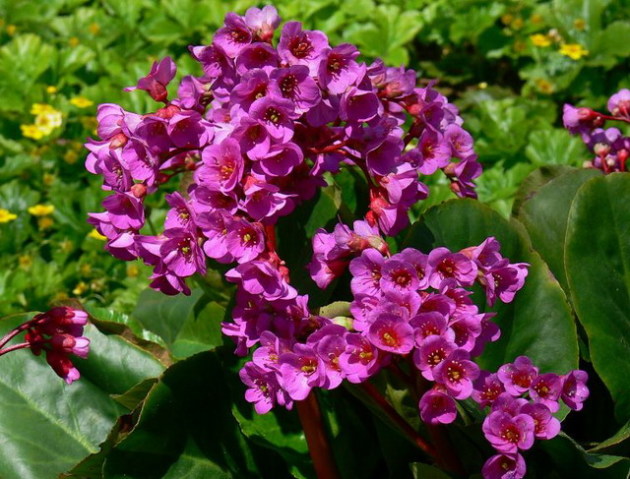
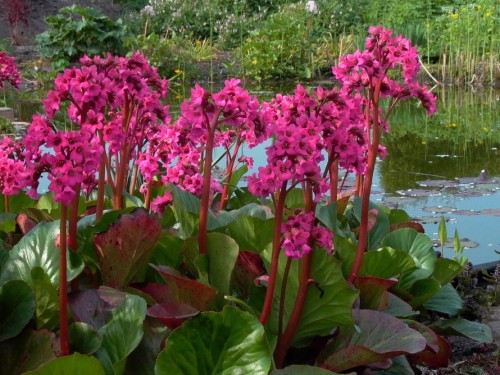
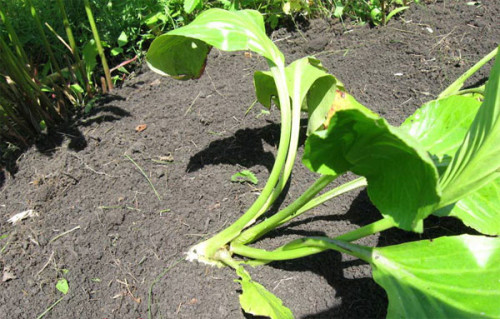

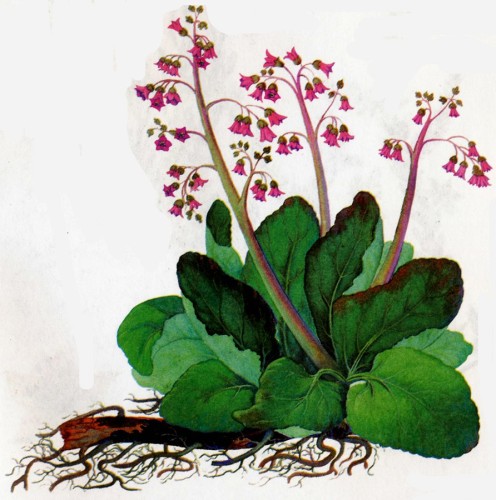
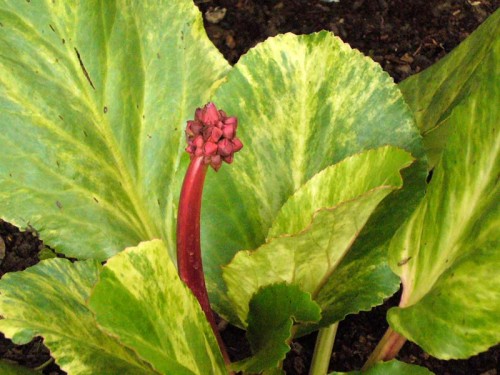
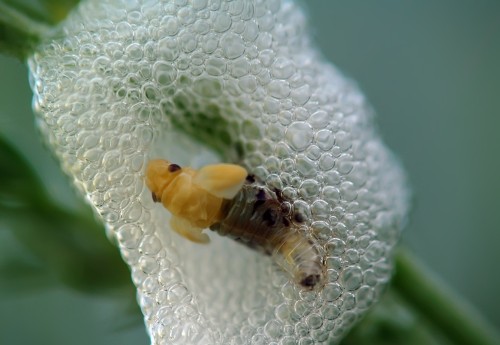
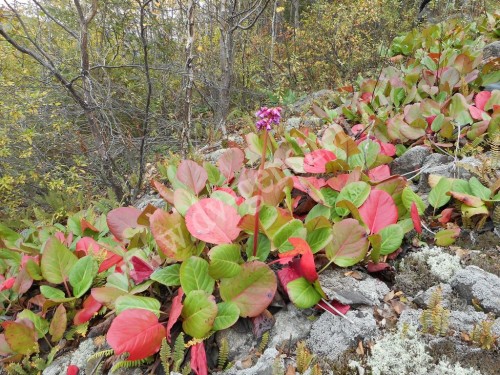
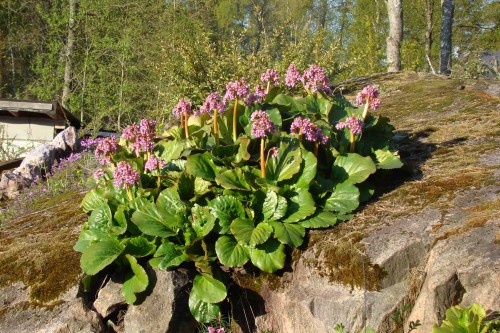
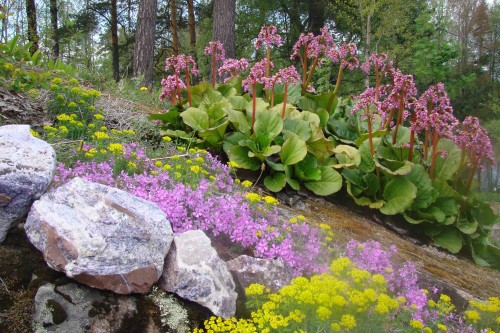





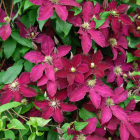
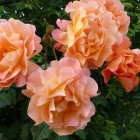

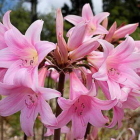
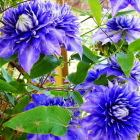
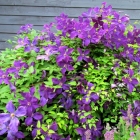
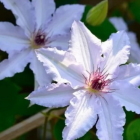
 Start a discussion ...
Start a discussion ...